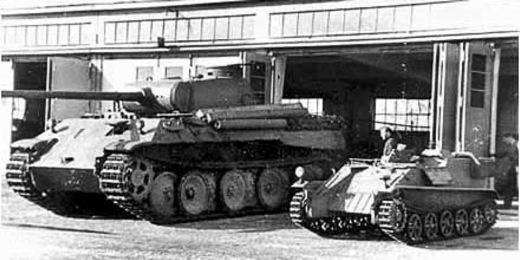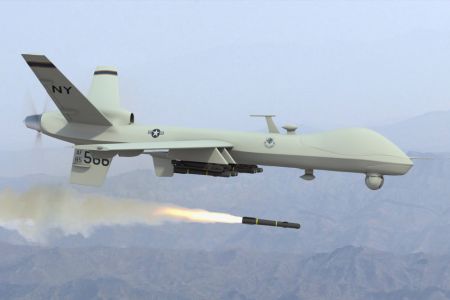Teleoperated Vehicles: Remote Controlled Battlefields and Beyond
Matthew Nelson
A teleoperated system, a vehicle remotely controlled by a human pilot, is a type of cyborg system. It is a fusion of man and machine operating over a distance, an intermittent cyborg. Intermittent cyborgs are combinations of man and machine that create a system that exists for a limited time (6). These vehicles are also called drones and have a surprisingly long history.
First Steps and World War Two
The very first remotely controlled vehicle was produced by Nikola Tesla in 1891. He built and demonstrated to the U.S. Army a boat that could be remotely controlled, hoping to use the remote control scheme for torpedoes. The Army did not purchase Tesla's design (12).
Sixty years later the first mass produced remotely controlled vehicles were on the battlefields of Europe. The Goliath tracked mine was first produced by the German army in late 1940 and deployed in 1942. It was a small vehicle that carried between 75 and 100 kilograms of explosives and was used to destroy fortified buildings and tanks. The Goliath was controlled by a joystick on a remote control unit connected to the vehicle by a triple strand telephone cable. It was also very compact, best seen in Picture 1 (1).
Over 7,000 Goliaths were produced over the course of the war, but the design had a number of drawbacks. The telephone cable linking the control unit to the vehicle was vulnerable to being cut by explosions from artillery fire or even by enemy infantry. The Goliath was also slow, moving only 9.5 kilometers per hour (6 mi/hr) (1).
The "bigger brother" of the Goliath was the Borgward IV demolitions carrier. This was a larger vehicle based on the small Panzer I tank and weighed 3.6 tons. It was designed with a fold down driver's seat and controls allowing it to be driven to the battlefield and then switched over to remote control (9)
It had several key differences from the Goliath. The Borgward was radio controlled which allowed the operator to stay further away. It was faster, reaching up to 38 km/hr. And most importantly, it was designed to deliver it's cargo of 500 kg of explosive by sliding it off the front armor panel, allowing it to be reused. Finally, in 1943, a prototype Borgward was produced that used a television camera and monitor to allow the operator to watch the machine's progress (9).
Overall, the Borgward and Goliath could be considered groundbreaking. They were the first large scale use of unmanned vehicles in warfare. However their flaws and lack of real impact on the war may have led to their obscurity today.

Borgward IV (left) next to a Panther Tank. WWII.
Vietnam - Goliaths in the Sky
Just as World War Two brought the first major use of unmanned ground vehicles (UGVs) Vietnam brought the first major use of unmanned aerial vehicles (UAVs). This was the beginning of a wide scale use of aerial drones and guided weaponry ("smart" bombs and guided missiles).
The first air to ground guided missile was introduced into service prior to the Vietnam War and was used with limited success. It essentially functioned like a Borgward IV, being remotely guided by the pilot using a separate joystick control setup. This separate control meant a pilot had to handle both the missile and the aircraft at the same time (2).
Similarly, the Falcon air to air guided missile suffered from several design flaws. The key flaw involved the coolant used to cool the guidance system built into the missile. The Falcon lacked sufficient coolant, leading to problems with the electronics and a mandatory cooling period before the missile could launch (up to five seconds). Repeated attempts to fire the missile exhausted the coolant and prevented the missile from firing at all. This meant the Falcon missile was effective only seven percent of the time, an extremely low number compared to the projected ninety-nine percent (2).
The performance of missiles and drones in Vietnam could be compared to the performance of the Goliath in World War 2. Both were groundbreaking in their use in war but had obvious flaws that prevented them from working as effectively as had been envisioned.
Today and Tomorrow - Drones in the U.S.
There are currently a number of drones deployed by the U.S. military in Iraq and Afghanistan, both in the air and on the ground.
The TALON SWORDS vehicle, advertised as a military robot, has had a small deployment in Iraq. It's a small treaded vehicle designed to mount a machine gun, 40mm grenade launcher, or anti-tank missiles. The entire unit weighs 115 pounds and is controlled via fiber optic line or radio (3).
Amongst many UAVs deployed by the U.S., the Predator is the most well known. It is designed as "a long endurance, medium altitude unmanned aircraft system for surveillance and reconnaissance missions" (14). Predators are currently in use in the U.S. and Italian militaries. They can operate for over 24 hours straight and carry up to 450 pounds of payload, which can include Hellfire missiles (4, 14).
These drones are in front line use today in Iraq and have shown some initial successes, though it may be easier to obtain data on their combat effectiveness after the current conflict. The Predator is planned to stay in service until 2025, with the Predator B (which has upgraded engines and electronics) in service until 2030. Plans for future UAVs include reduced noise signature, increased engine efficiency and increased amount of data relayed to controllers (8).

Today and Tomorrow - Europe
Europe has been extensively testing teleoperated vehicles for several years now in an annual event called the European Land Robot Trials (ELROB). Started in 2006, the ELROB trials test a number of entries from European universities and corporations in both civilian and military applications. The focus is on "short term realizable robot systems" which might mean catching up to the U.S. in terms of ready to deploy unmanned vehicles (5).
The tests take place at the German Army Infantry School in Hammelburg, Germany. Tests include surveillance and location of objectives in urban and mixed countryside environments and scenarios involving vehicles working autonomously. In 2007 thirteen teams from five European nations participated (5).
One of the more prominent participants in the ELROB trials is Rheinmetall AG, a German company that produces military hardware, including the cannon used in the M1 Abrams tank. Rheinmetall's previous entries in the contests include a small unmanned ground vehicle equipped with an arm for explosives disposal and a larger eight wheeled vehicle called the Smover (5, 10).
The Smover is a one ton "hybrid" vehicle - it can be piloted remotely or conventionally from an on-board steering wheel. The hybrid design is supposed to reduce the logistic support needed by a force because unmanned vehicles that have damaged remote control systems can still be piloted manually (10).
Another competitor participating in the trials is Macroswiss S.A. who entered the 2007 civilian competition with an ironically small (as the group is called Macroswiss) unmanned vehicle. Their aim was to produce a small, cheap vehicle for use in urban conditions. Named Spyrobot Mk. II, it is intended for reconnaissance, though the production model would be able to mount small weapons.
Non-military Drones
Teleoperation has many uses off the battlefield, in particular for accessing remote or hostile locations. This can be anything from the surface of other planets to the site of a hazardous material spill. In particular, surveillance and bomb disposal are tasks that carry over from military to civilian applications and seem to be where drones are entering everyday life.
In addition to existing surveillance drones, the Pentagon plans to introduce micro air vehicles (MAVs) which can recharge themselves by landing on power lines. The MAV would include sliding panels and collapsible wings allowing it to land and disguise itself. This system implies that they may be used for domestic surveillance. While this brings up many ethical issues regarding privacy, it also brings up worries about the possible damage of a bad landing on power lines. Ian Fells, an expert on power transmission in the United Kingdom said "Even kites falling across power lines cause breakdowns." (7).
On the other hand, teleoperated reconnaissance vehicles may be useful to organizations other then the government. The System 77 Civilian Counter Reconnaissance program is a project designed to test unmanned aerial vehicles for use in urban environments to provide a bird's eye view of activities to coordinate protesters and monitor police movements (13).
Future Trends
One member of a team participating in the ELROB in 2006 trials commented "Handling and remote control of robots is and will be a major issue in the future"(5). The technology behind unmanned vehicles has become smaller and more powerful with the use of computers and smaller more powerful radios. Advances in computing, especially wearable computing (in which processors and circuitry could be integrated into clothing) and direct neural interfaces could allow easier and less conspicuous control of vehicles.
Off the battlefield it seems impractical to use unmanned vehicles in anything other than the usual bomb disposal application. UAVs would have to contend with power lines and each other to avoid collisions and electrical disasters from power lines. Unmanned ground vehicles would have to deal with ground traffic, some of which would be many times the size of the vehicle, especially for small drones such as the one demonstrated by Macroswiss. Better Unmanned vehicles seem to have made a place for themselves, but will most likely not spread to everyday life in the near future.
Sources
1. Chmaberlain, Peter and Doyle, Hillary. Encyclopedia of German Tanks of World War Two. 2nd edition. 1999 London: Arms and Armor
2. Directory of U.S. Military Rockets and Missiles. AGM-12 Bullpu and AIG-4 Falcon. Updated November 20, 2007. http://www.designation-systems.net/dusrm/m-12.html and
http://www.designation-systems.net/dusrm/m-4.html
3. Foster-Miller Inc. "TALON Robots; Small Mobile Weapons System for Force Protection". Pamphlet available at http://www.foster-miller.com/lemming.htm
4. General Atomics Aeronautical Systems. MQ-1 Predator.
http://www.ga-asi.com/products/predator.php
5. German Federal Armed Forces and NATO. European Land-Robot Trial. http://www.elrob.org/
6. Gray, Chris H. with Mentor, S. and Figueroa-Sarriera, H. The Cyborg Handbook. 1995. P. 14
7. Marks, Paul. The Pentagon's New Line in Powered Flight. New Scientist p.22. January 5, 2008
8. Office of the Secretary of Defense. Unmanned Aerial Vehicles Roadmap 2002-2027.
United States Department of Defense. December 2002
9. Olsson, Thorleif. "Borgward IV - SdKfz. 301". October 19, 2007
http://www.achtungpanzer.com/articles/borgward.htm
10. Rheinmetall AG. "European Land Robot trials Ð Elrob 2006". August 2006
http://www.rheinmetall-defence.com/index.php?fid=3821&lang=3n
11. Robowatch Technologies Ltd. "CHRYSOR - Cutting Risks While Maximizing Security".
http://www.robowatch.com/index.php?id=303
12. Tesla, Nikola, "My Inventions", Electrical Experimenter magazine, Feb, June, and Oct, 1919.
13. The S-77 CCR Consortium. "System-77 Civilian Counter-Reconaissance". May 27, 2004.
http://s-77ccr.org/
14. United States Ari Force. Predator - Unammned Aerial Vehicle.
http://www.airforce-technology.com/projects/predator/
Image Sources
http://2.bp.blogspot.com/-BP8qx4tG0W8/TwZXyk_y6fI/AAAAAAAADWk/xdeBx2Nx42Y/s640/1272109715_2.jpg
http://previous.presstv.ir/photo/20110523/gholizadeh20110523134107250.jpg
|

